DIXON
ILLINOIS
BOYHOOD HOME OF OUR 40TH PRESIDENT,
RONALD REAGAN
by
Peter P. Bozanich
Author's
note: These
are pictures I took on my most recent trip to Dixon, Illinois in the Fall
2003. Ronald Reagan was the first American President of my adult life.
I will miss him greatly.
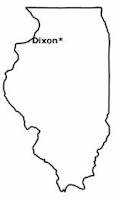 |
Ronald Reagan was born in Tampico, IL in 1911. His family
even spent some time on the south side of Chicago. But spent
from age 9 to age 21 in Dixon. These were his formative years
and Dixon was the only town he ever referred to when he told
about growing up.
GROWING UP POOR
“Later
in life I learned that, compared with some of the folks
who lived in Dixon, our family was "poor."
But I didn't know that when I was growing up. And I
never thought of our family as disadvantaged. Only later
did the government decide that it had to tell people
they were poor.” |
|
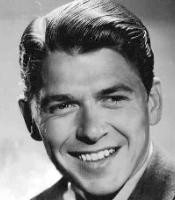 |
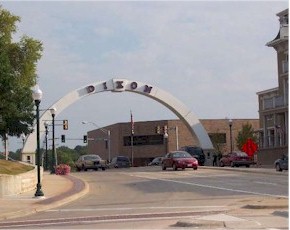 |
This was “the good life”
for Reagan. He loved his days on the Rock River so much that
he had a picture of the beach where he worked as a lifeguard
for 7 years on his wall in the Oval Office.
You can bearly see the picture hanging
on the far right of this photo. |
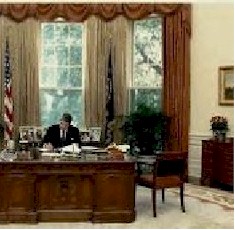 |
THE GOOD LIFE
“As
I look back on those days in Dixon, I think my life
was as sweet and idyllic as it could be, as close as
I could imagine for a young boy to the world created
by Mark Twain in The Adventures of Tom Sawyer.”
|
|
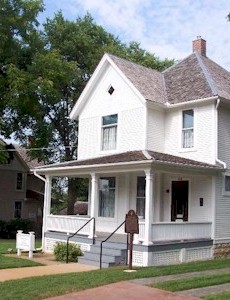 |
REAGAN’S BOYHOOD
HOME
“I
think growing up in a small town is a good foundation
for anyone who decides to enter politics. You get to know
people as individuals, not as blocs or members of special
interest groups. You discover that, despite their differences,
most people have a lot in common: Every individual is
unique, but we all want freedom and liberty, peace, love
and security, a good home, and a chance to worship God
in our own way; we all want the chance to get ahead and
make our children's lives better than our own. We all
want the chance to work at a job of our own choosing and
to be fairly rewarded for it and the opportunity to control
our own destiny.” |
|
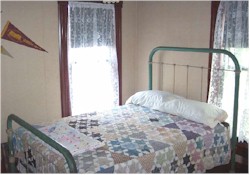 |
| This is the bedroom Ronald Reagan shared with his
brother. They have it decorated with sports pennants. There’s
even a bat and glove near the closet. Reagan’s home
is located a few blocks from the Rock River at 816 Hennepin
Avenue. It was restored to the 1920’s period after he
became President.
|
When he returned to Dixon to see it he said: “if I knew
it was this nice, I may have never left”. He also commented
how low to the ground everything was now. He remembered everything
being “much bigger”. A phenomenon of growing up,
I guess.
|
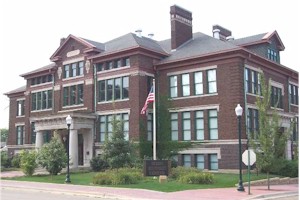 |
This is the school Reagan attended - only a few blocks away
from his house.
DIXON HIGH SCHOOL
“When I entered Dixon High School in 1924,
I was thirteen and worshipped football more than anything
else in the world. I wanted desperately to play for the
school team. The fact that my brother was already a starter
on the team only intensified my resolve.
“Then one Saturday morning, the coach, who had decided
he was unhappy with the playing of one of our first-string
guards, convened our regular pre-game meeting in the locker
room and, reading off the starting team, said - I'll never
forget it - ‘Right Guard - Reagan.’
“Once I got in, I never let the other guy get his
position back. The first string job was mine for the rest
of the season and during my senior year, when I'd grown
even bigger, I was a starter from the beginning.” |
|
LOWELL PARK
“About my second year in high school, I
got one of the best jobs I ever had: I began the first
of seven summers working as a lifeguard at Lowell Park,
a three-hundred-acre forested sanctuary on the Rock River
named for the poet James Russell Lowell, whose family
had given the property to the city. I'd taken a course
on lifesaving at the YMCA and when an opening for a lifeguard
came up, I went to my old employer in the construction
business and told him I was going to have to quit. I worked
seven days a week, ten to twelve hours a day, for $15
- later $20 - a week and one of the proudest statistics
of my life is seventy-seven - the number of people I saved
during those seven summers.” |
It is no longer a swimming beach but a plaque is there commemorating
Reagan’s heroics.
|
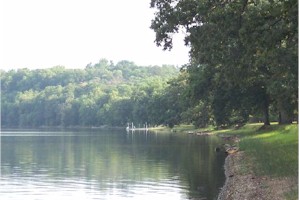 |
FREEDOM TO FOLLOW YOUR
DREAMS
“The dreams of people may differ, but everyone
wants their dreams to come true. Not everybody aspires
to be a bank president or a nuclear scientist, but everybody
wants to do something with one's life that will give him
or her pride and a sense of accomplishment. And America,
above all places, gives us the freedom to do that, the
freedom to reach out and make our dreams come true.” |
|
Many people remember Ronald Reagan for bringing honor and hope
to our country. He stood against an overspending Congress and
fought against the moral decay of abortion and porn. But perhaps
his biggest achievement was his fight for the cause of freedom. |
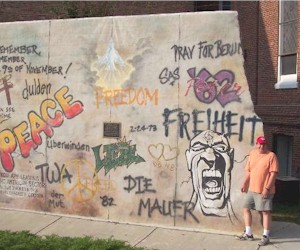 |
END OF SOVIET COMMUNISM
Mikhail Gorbachev credits one man, Ronald Reagan, for bringing
about an end to Soviet communism.
A large chunk of the Berlin Wall sits on display in Dixon
- a poignant monument to freedom and the man who played a
key role in bringing about that freedom.
On the front of the Wall are joyful expressions of that freedom.
|
|
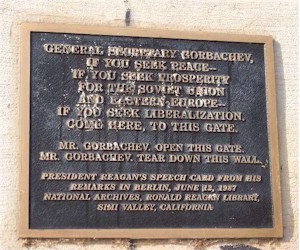
|
In the center you see a plaque commemorating Reagan’s
pivotal speech imploring the Soviet leader to let his people
be free.
The back of the Wall is empty except for one small painting
- a stark reminder of oppression left behind. |
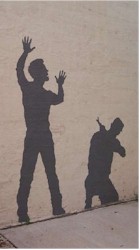 |
| WINGS OF FREEDOM
Other art pieces adorn the area.
The statue on the right, “Wings of Freedom”,
was donated by Bulgarian artist Nick Tanev as an “expression
of gratitude for President Ronald Reagan for his part in ending
the Cold War”. Mr. Tanev attributed his own success
and good fortune to his leaving the oppression of communist
Bulgaria “for the prosperity and hope he found in the
United States of America”. The sculpture is a symbol
of the joy and triumph he found in the peace and freedom in
his new adopted homeland.
|
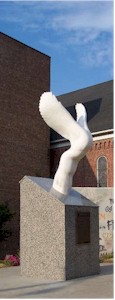 |
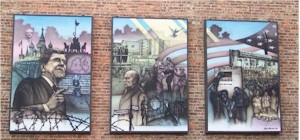 |
THE END
|
|












